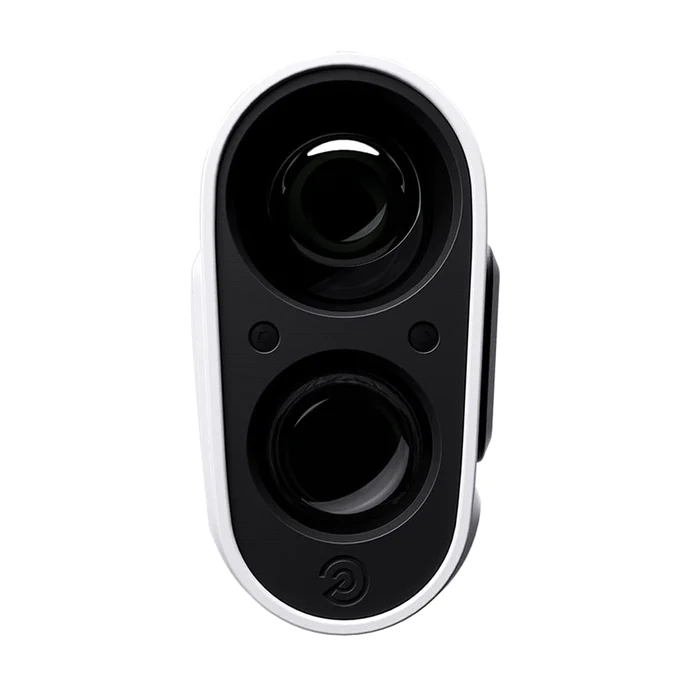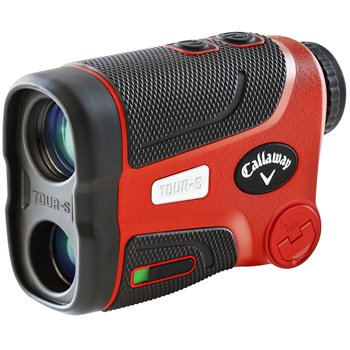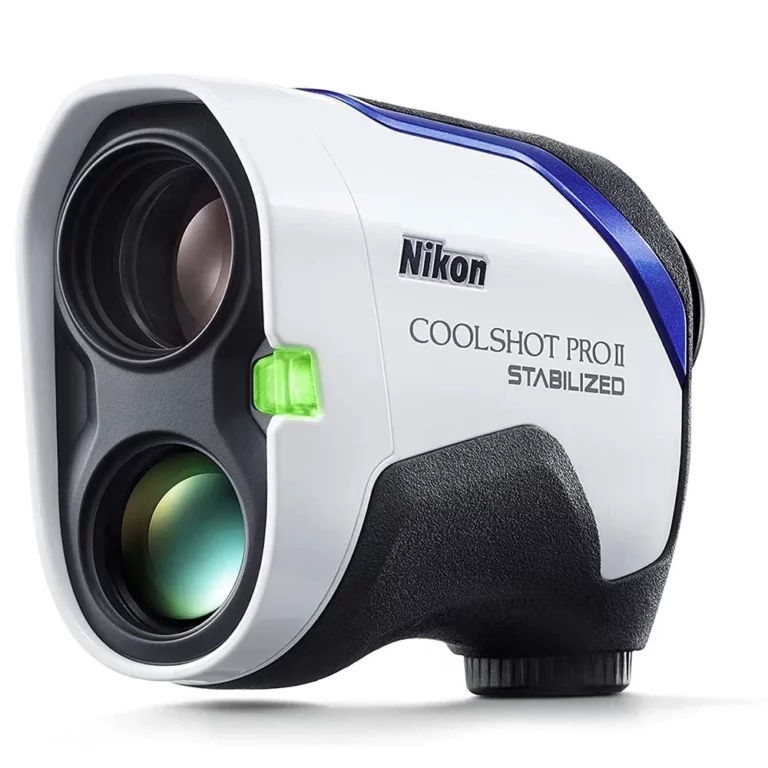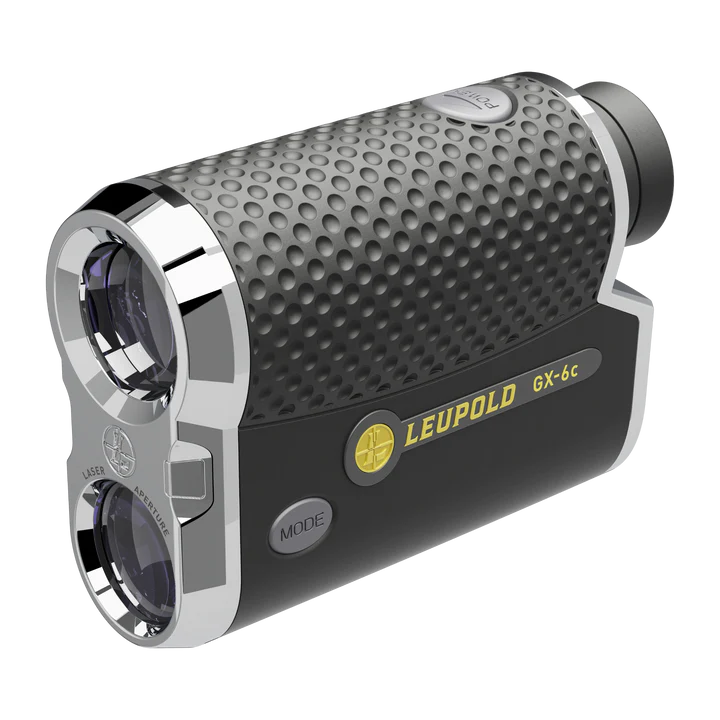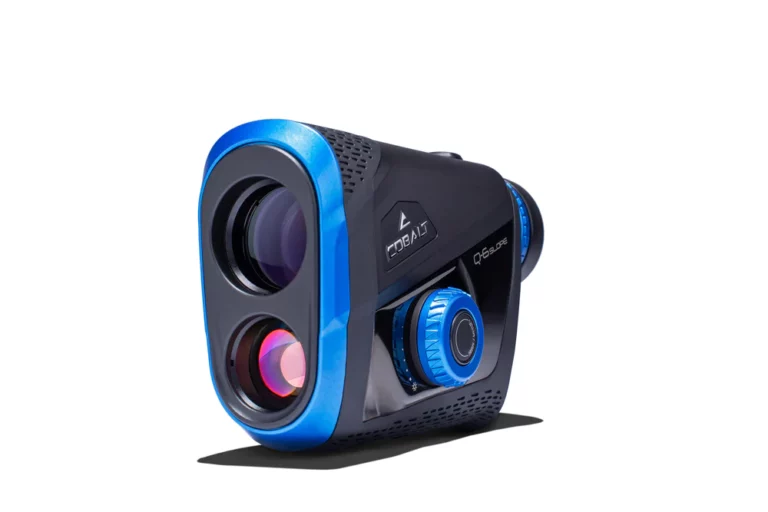If you want to understand the inner workings of how golf rangefinders work, this article is for you. It will help you understand which components and features are most important, and can help you in your search for a great golf rangefinder.
We will cover technical aspects such as how slope works, how environmental factors affect a rangefinder, how optics work, and more.
Use this article in conjunction with our post How to Choose the Best Golf Rangefinder to find your perfect rangefinder.
Overview
Most golfers likely don’t sit around wondering how golf rangefinders work. They just want to buy one that meets their needs, and have it work.
On the exterior, they seem like a simple device. Point at a target, click a button and the yardage appears. However, when looking at the premium rangefinder market, there are a lot of differences that separate lower-end rangefinders from the best.
However, in order to know what to look for, you first need to understand how a golf rangefinder works. Once you understand that, you can look for rangefinders that have the features (and quality) to meet your needs.
This post will go in-depth into how each component of a golf rangefinder works. We will cover the following topics:
- Basic Operation – how a golf rangefinder measures distance
- Slope – how slope is calculated
- Algorithms – what algorithms are and how rangefinders use them
- Optics – rangefinder optics including different types
- Displays – rangefinder display types and how they work
- Lasers – types of rangefinder lasers
- Stabilization – an understanding of how this technology works
- Pin Acquisition – what is Pin Acquisition technology and how it works
- Range – how range works & why it matters
- Weather Resistance – how this is measured and what it means
- Accuracy – how environmental factors affect accuracy
Let’s get started with the first topic.
The Basic Operation Of Golf Rangefinders

At the core, golf rangefinders exist to do one thing; measure distance. You point at a target, click a button, and then the rangefinder shows you how far that target is from your current location.
But what is really happening inside the device?
Technical Explanation
A laser rangefinder works by sending out a laser pulse and measuring the time it takes for the laser to bounce back off the object and return to the rangefinder.
A laser rangefinder then uses the formula to calculate the distance to the object:
Distance = (Speed of Light * Time) / 2
The speed of light is a constant (~186,282 miles per second), so by knowing the time it takes for the laser to bounce back, distance can be calculated.
Role of the Microprocessor
The microprocessor is a small computer chip that is built into the rangefinder. It is the “brains” that actually performs the distance calculation and sends the data to the display screen.
It is also used in the Slope calculation (which is covered below).
Here’s how it works:
- The rangefinder sends out a laser beam towards a target
- When the beam reaches the target, it reflects back to the rangefinder
- The rangefinder measures the time it takes for the beam to travel to the target and back
- The microprocessor receives the time measurement and uses it to calculate the distance to the target
- The calculated distance is displayed on the rangefinder’s screen
In essence, the microprocessor acts like a tiny brain that performs the calculation and displays the result. The microprocessor is able to make this calculation because it knows the speed of light, which is the speed at which the laser beam travels, and it uses this information to determine the distance to the target.
Simple Explanation
The process is similar to if you knew how fast a plane was traveling, and for how long it was traveling, you could calculate how far it has gone.
That is oversimplifying it as a plane would travel at variable speeds. But assume the speed of the plane was constant and then it makes more sense.
How Slope Works
Most laser rangefinders on the market today come with a feature called “slope“. This is a big category differentiator between rangefinders. Either they have slope or not.
Slope compensates for the elevation change between you and the flagstick and calculates a true yardage.
We highly recommend getting a rangefinder with slope. You can always turn it off, but if you buy one without slope you are out-of-luck if you need that feature. The price difference is not that much making it worthwhile.

For example, let’s say you are standing on a hill and looking down at the flagstick. A standard laser rangefinder will give you the distance to the flagstick.
With a slope rangefinder, it will also take into account the fact that you are standing on a hill above the flagstick. Slope will calculate an adjusted distance to the flagstick, taking into account the elevation change.
Technical Explanation
A golf rangefinder with slope technology can determine the incline of the terrain between the golfer and the target using a built-in inclinometer or a gyroscope.
Manufacturers keep their internal technology a closely-guarded secret. Therefore, you won’t find much info on how they calculate slope.
Occasionally, you will see mention about an Inclinometer (for example), but most of the time they only talk about features.
Here’s how the slope calculation works:
- The rangefinder sends out a laser beam towards a target
- When the beam reaches the target, it reflects back to the rangefinder
- The rangefinder measures the time it takes for the beam to travel to the target and back
- The inclinometer measures the angle of the slope between the golfer and the target.
- The microprocessor receives the time measurement and angle of the slope and uses this information to calculate the distance to the target
- The slope-adjusted distance (and actual distance) is displayed on the rangefinder’s screen
Inclinometer
An inclinometer is a device that measures the angle of the slope. It has special sensors that can identify the angle of the slope between you and the target.
HOW AN INCLINOMETER WORKS An inclinometer works by measuring the change in orientation or angular velocity of the rangefinder, and using this information to calculate the angle of slope between the golfer and the target. In essence, the inclinometer works like a tiny protractor that measures the angle of the slope The microprocessor then uses this information to make an adjustment to the calculated distance, taking into account the slope of the terrain.
Gyroscope
Most people are more familiar with a gyroscope as they are present in many smartphones (such as iPhones).
Used in a rangefinder, a gyroscope measures the angular velocity of the rangefinder, and uses this to determine the angle of slope based on changes in angular velocity.
HOW A GYROSCOPE WORKS A gyroscope measures if the rangefinder is level to the ground, or if it is being held at an angle. If it is held at an angle when measuring a target, this info is used in the distance calculation to give a "slope-adjusted" distance.
Slope Algorithms
The best golf rangefinders with slope functionality use advanced algorithms to improve the accuracy of the slope measurements.
The word algorithm gets thrown around a lot these days. So what does algorithm mean?
According to the Oxford Dictionary, an algorithm is defined as this:
algorithm: a process or set of rules to be followed in calculations or other problem-solving operations, especially by a computer.
How Slope Algorithms Work
Premium rangefinders use sophisticated algorithms to account for factors such as elevation changes and atmospheric conditions that can affect the accuracy of the measurements.
The rangefinder measures these conditions, and then feed it to the algorithm. The algorithm then makes further adjustments to the distance/incline measurements it has made.
The end result is a more accurate “adjusted” distance.
Note: we will talk more about the impact of altitude and environment in the section on Accuracy below.
Is The Slope Feature Worth It?
YES! Slope is a great feature to have if you are playing on a course with a lot of elevation changes. It will give you adjusted “true” yardages to target and can help lower your score.
You can also avoid coming up short/long on holes with an elevation change. It is worth it to have and the disable when you don’t need it.
Note that on you can turn off slope on almost every (if not all) rangefinder that comes with slope to make it tournament legal.
Optics
Optics in a golf rangefinder refer to the lenses and other components that make up the device’s optical system.
The optics are responsible for transmitting the laser signal, focusing the image, and providing the magnification. High-quality optics are essential for a rangefinder to provide accurate and clear measurements.

To identify high-quality optics in a golf rangefinder, consider the following factors:
- Glass quality: The lenses in a rangefinder should be made of high-quality glass that is clear, durable, and resistant to scratches.
- Coatings: Look for rangefinders with multi-coated lenses that reduce glare and increase the clarity of the image.
- Magnification: A rangefinder with a magnification of 6x to 7x is ideal for golf. Higher magnification may not necessarily result in better optics.
- Focus: A rangefinder with a quick and easy-to-use focus system is essential for golfers to quickly adjust the focus to their preference.
- Field of View (FOV): This determines how wide of a view you have when looking through the viewfinder
Glass Type
The best type of glass to use in a golf rangefinder optic is one that provides high clarity, durability, and resistance to scratches. There are two types of glass that are commonly used in golf rangefinders: BaK-4 & BK-7.
BaK-4
The most commonly used type of glass in rangefinders is BaK-4 prism glass. It is a high-density glass with anti-reflective coatings.
BaK-4 prism glass is generally considered the best type of glass to use in a golf rangefinder optic due to its high clarity and durability.
BK-7
BK-7 glass is less expensive than BaK-4 but does provide a decent level of clarity and light transmission.
While the differences can be hard to tell in normal light, the BK-7 will struggle when light levels drop due to the lower-quality prisms in BK-7.
Coatings
The best optics coatings on rangefinders are those that provide maximum light transmission and minimize glare and reflection.
Premium rangefinders will have fully multi-coated lenses.
Fully multi-coated lenses
have multiple layers of anti-reflection coatings providing the highest level of light transmission. This results in bright and clear images, even in low light conditions.
Coated lenses
have a single layer of coating on one surface, which provides some reduction in glare and improved image contrast.
Good coatings also help to protect the lenses from scratches and damage, extending the life of the rangefinder. Additionally, anti-reflective coatings can reduce the amount of glare and improve the visibility of the target, making it easier for the golfer to aim the rangefinder accurately.
Magnification
Magnification refers to the level that an image is magnified when looking through the viewfinder.
The higher the magnification, the closer the image appears. This helps the golfer get a clearer view of the target and make more accurate distance measurements.
Most golf rangefinders have a 6X magnification with a few high-end models offering 7X magnification.
Focus
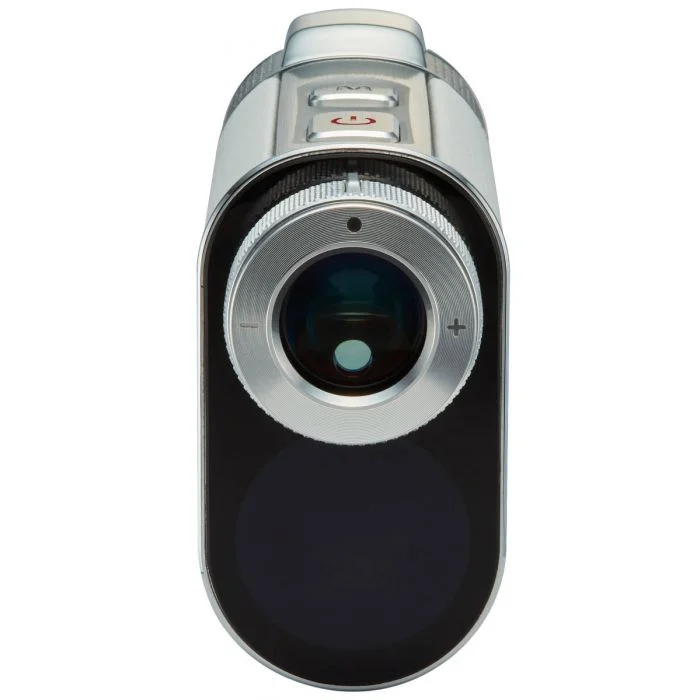
Focus gives the golfer the ability to adjust the view to suit their eyes. Almost every golf rangefinder has a ring that is manually turned so you can set the focus to be clear for your vision.
Field of View
Field of View (FOV) refers to how wide of the landscape you see when looking through the lens. It is typically measured in feet.
An example would be FOV – 340 ft @ 1,000 yards
So, if a golfer is using the rangefinder to measure the distance to a target 1,000 yards away, the device will show an image of the target and the surrounding area of 340 feet in width. The actual size of the field of view will depend on the magnification of the device and the user’s eyesight.
A field of view of 340 feet is considered to be a fairly standard measurement for golf rangefinders.
Rangefinder Display
The display is very important as that is what you see when looking through the viewfinder. In the premium space, the screens are typically OLED which is the best option. However, some rangefinders still use LED displays.
LCD Displays

This is the most common type of display found on golf rangefinders. LCD displays use a backlight that shines through colored filters.
They are less expensive than OLED, but use more power and do not have the same image quality as OLED.
It typically shows a monochrome display with the distance readings. These can be harder to read in low-light conditions.
OLED Display
Most common on high-end golf rangefinders. OLED displays work by turning on/off individual pixels. This means the display does NOT need a backlight (more energy-efficient).
It also provides deeper blacks and more crisp colors.
OLED displays can shift colors depending on outdoor conditions.
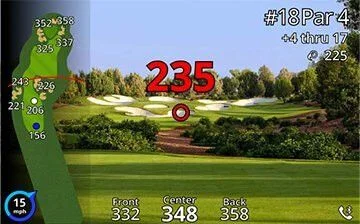
When it is bright out, the data is displayed in red & green. When it is darker out, it switches to black numbers on a gray background. This makes it much easier to see the numbers from the rangefinder.
They are also more energy-efficient, which can be important when using the rangefinder for an extended period of time.
Lasers
The rangefinder laser is used to bounce off the target and back to the rangefinder for calculating distance. The quality is important as environmental conditions will diffuse the laser beam (more on that later).
There are 2 types of lasers used in golf rangefinders.
Class 1 Laser
The most commonly used type of laser in golf rangefinders is a Class 1 laser. They are safe to use and are the most accurate laser for a golf rangefinder.
Class 1 Laser
Another type of laser used in rangefinders is the Class 3R laser. This type of laser is also safe for the eyes but is less precise than Class 1 lasers. Class 3R lasers are typically found in lower-end rangefinders and are not as accurate as a Class 1 laser.
Stabilization
Golf rangefinder stabilization technology is a feature that helps to improve the accuracy of distance measurement by compensating for any hand movements or vibrations during the measurement process.
Stabilization technology uses sensors (such as gyroscopes) and algorithms to detect and compensate for any movement or vibrations in the rangefinder. The sensors detect the movement and send a signal to the algorithm, which then adjust the laser beam to compensate for the movement.
This results in a more accurate distance reading, even if the the device is moving.
For instance, playing in windy conditions can make it difficult to lock onto the correct target. Or some people have a natural shake in their hands. Stabilization technology can help with these scenarios.
Pin Acquistion
Pin acquisition technology is a feature found in some golf rangefinders that helps golfers accurately target the flagstick on the green. It works by using multiple lasers to scan the area in front of the rangefinder and then using algorithms to determine the position of the flagstick. The rangefinder then focuses the laser beam on the flagstick, ensuring an accurate distance measurement.
Here’s a technical explanation of how pin acquisition technology works:
The rangefinder emits multiple laser beams that scan the area in front of the device.
The laser beams bounce off objects in the area, including the flagstick, and return to the rangefinder.
The rangefinder measures the time it takes for each laser beam to travel to the target and back and uses this information to calculate the distance to each object. It can prioritize the closest object in the viewfinder, ensuring that you get an accurate reading to the flagstick, even if other objects are in the background.
The algorithms in the rangefinder analyze the distance measurements and determine the position of the flagstick based on its relative position to other objects in the area.
The rangefinder then focuses the laser beam on the flagstick, ensuring an accurate distance measurement.
Range
Range is a number that is expressed in yards. Such as a range of 600 yards. In reality, all premium golf rangefinders have more range than you can use.
This is another feature that is a combination of the entire rangefinder’s parts & capabilities. In general, the further the range, the better the rangefinder quality.
Golf rangefinders tend to be more accurate the closer they are to the target. This is because the laser beam used in rangefinders has a limited spread, so the closer the rangefinder is to the target, the smaller the area that the laser beam covers, which results in a more accurate measurement.
And this is the key. You need more accuracy as you get closer to the target and that is exactly what a laser rangefinder delivers.
Weather Resistance
Most golf rangefinders are rated for some level of water resistance. The most common rating is an IPX rating.
IPX Rating
Ingress Protection rating (IPX) is an international standard that measures resistance to dust and water. The rating system ranges from IPX0 to IPX8, with higher numbers indicating higher levels of protection.
The IPX rating is represented by two digits, with the first digit indicating the level of protection against solid particles (such as dust) and the second digit indicating the level of protection against liquids (such as water).
So if the item is rated at IPX4, that means it has no dust protection but level 4 liquid protection. The ‘X‘ means there is no rating.
IPX Levels
Here is an overview of the different IPX levels and what they mean for weather resistance.
See our post Understanding Waterproof Ratings for Golf Gear and Apparel for an in-depth explanation.
- IPX0: No protection against water or dust.
- IPX1: Protection against dripping water. The device can withstand water droplets falling vertically onto the device, but not spraying water from any direction.
- IPX2: Protection against dripping water when tilted up to 15°.
- IPX3: Protection against spraying water. The device can withstand water sprayed onto it from any direction, but not immersion.
- IPX4: Protection against splashing water from any direction.
- IPX5: Protection against water jets. The device can withstand water jets from any direction, but not submersion.
- IPX6: Protection against powerful water jets. The device can withstand powerful water jets from any direction, but not submersion.
- IPX7: Protection against immersion. The device can be temporarily submerged in water up to a specified depth.
- IPX8: Protection against continuous immersion. The device can be continuously submerged in water up to a specified depth.
Premium rangefinders will have an IPX4 rating, which means they are resistant to splashing water from any direction.
If you play in very rainy or humid conditions, consider a rangefinder with an IPX7 rating. If there is not an IPX rating listed, you can assume the rangefinder has minimal water resistance.
Rangefinder Accuracy
We left this topic for last because accuracy is combination of how all of the parts of golf rangefinder work together.
The components that make up a rangefinder have a massive impact on the accuracy of the device. Optics, lasers, algorithms, stabilization technology, weather-resistance, and algorithms all play a part in determining the accuracy of a device.
In addition to the components (which we discussed above), environmental factors can play a part in the overall accuracy of a rangefinder.
Environmental Factors Affect on Golf Rangefinder Accuracy
Environmental conditions can have a significant impact on the accuracy of a golf rangefinder. Weather, altitude, temperature, and more can diminish how effective a rangefinder performs.
Let’s look at these factors a little more closely to understand how they can affect a golf rangefinder.
Weather
Rain, fog, and other weather conditions can reduce the visibility of the target and make it more difficult for the rangefinder to obtain an accurate measurement.
Rain can affect the accuracy of a golf rangefinder in several ways. Raindrops can scatter the laser beam, causing it to diverge and become less focused. This can reduce the accuracy of the measurement, as the rangefinder may not be able to precisely determine the distance to the target.
Additionally, moisture in the air from rain can cause refraction of the laser beam, leading to inaccuracies in the measurements.
Temperature
Temperature can affect the accuracy of a golf rangefinder as it causes changes in the refractive index of the air. Refractive index is a measure of how much light is bent as it passes through the air.
When the temperature changes, the refractive index changes as well which can cause issues.
Additionally, extreme temperatures can cause thermal expansion of the rangefinder’s components, such as the lenses and body, which can cause misalignment and result in inaccurate measurements.
Altitude
The altitude at which the rangefinder is used can also impact its accuracy. Rangefinders may not be as accurate at higher altitudes due to changes in atmospheric pressure.
Altitude can affect the accuracy of a golf rangefinder because it can cause changes in atmospheric pressure, which in turn affects the refractive index of the air.
This is because the rangefinder’s laser beam travels through a greater distance of air at higher altitudes, which can cause more bending and cause the measurement to be less accurate.
Some rangefinders are designed to be more weather-resistant and adaptable to different conditions, making them a better choice for golfers who play in a variety of environments.
Conclusion
Hopefully this article answered any questions you had on how golf rangefinders work. See our article on How to Choose the Best Golf Rangefinder to help you identify what type of rangefinder will meet your needs.
Or skip right to our article on The Best Golf Rangefinders with Slope to see the best premium rangefinders on the market.
Thanks for reading!
Founder of TheLuxeGolf, I am an avid golfer with a single-digit handicap with over 20 years of experience playing golf. I use my analytics education from Georgia Tech to help me research and write the best articles on luxury & premium golf products! I love how analytics has seeped into every aspect of golf and how it can be used to provide incredible insights into your game. In my time, I’m either writing about golf, watching golf, or playing golf!



